The Costa Concordia was one of the most luxurious ships in the world. Built at a cost of $570 million dollars, she boasted no less than five restaurants, 13 bars, and four swimming pools.
She was the flagship of her fleet and one of the largest cruise liners in the world, but in January 2012 she ran aground in one of history’s most infamous maritime disasters.
32 people lost their lives, the ship’s captain was imprisoned, and the luxury cruise industry itself came under intense scrutiny.
This list takes a closer look at the Costa Concordia disaster.
10. Costa Concordia was Bigger than the Titanic
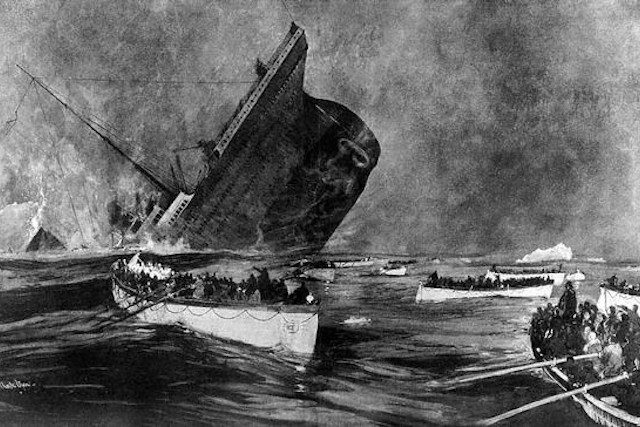
When the Titanic set sail on her fateful maiden voyage in April of 1912 she was the largest passenger ship the world had ever seen. She measured 882 feet long, carried 2,224 passengers, and weighed in at 114,000 tons.
At the time this was pretty much as big as any ship could be, but modern engineering methods and technologies mean that modern passenger ships can be substantially larger. This included the Costa Concordia which was longer, taller, heavier, and able to carry almost twice as many people as the Titanic.
Unlike the Titanic, the Costa Concordia came equipped with a full complement of lifeboats and the modern safety features designed to prevent disaster. The huge ship boasted technology that could precisely pinpoint her location anywhere on the globe, seabed sonar, and watertight compartments that could be sealed off from the bridge.
Despite looking somewhat unstable due to their imposing height, modern cruise ships are designed and tested to be capable of riding the waves even in hurricane conditions.
Despite all this the Costa Concordia was lost in calm conditions in shallow water. It took the Titanic two hours and forty minutes from striking the iceberg to slipping beneath the icy Atlantic Ocean. Despite her modern construction techniques and technology, the Costa Concordia keeled over within two hours. Only shallow waters prevented her from being lost beneath the waves entirely.
9. The Captain Diverted from the Official Route
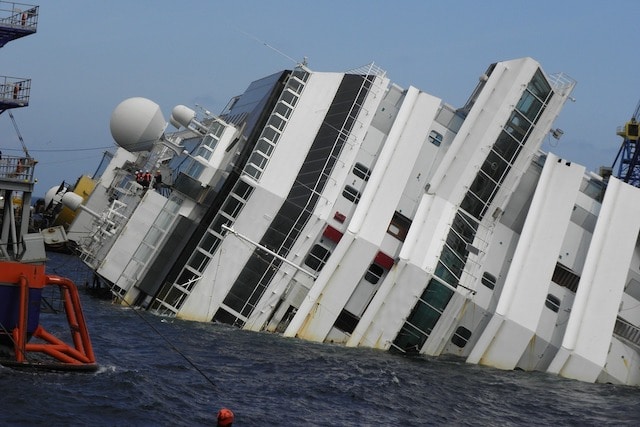
At 7 p.m. on January 13, 2012 the Costa Concordia set sail from the port of Civitavecchia near Rome. She was undertaking a luxury Mediterranean cruise scheduled to last seven days, with the next port of call in Northern Italy.
The route was pre-planned and carefully mapped out, and it should have seen the massive ship pass safely through deep waters between Giglio island and the Italian mainland.
In what would prove to be a fatal decision, captain Francesco Schettino ordered his crew to plot a new course. He planned to perform what is known as a sail by salute, taking the ship perilously close to the rocky shores of Giglio Island.
It has been suggested that Captain Schettino performed this maneuver in order to impress his mistress, who he had brought aboard without a ticket.
However, it later emerged that these sail by salutes were commonplace and unofficially sanctioned by the cruise lines, as they provided a business-boosting spectacle for passengers and those watching from the land.
8. The Ship Struck a Rocky Outcrop
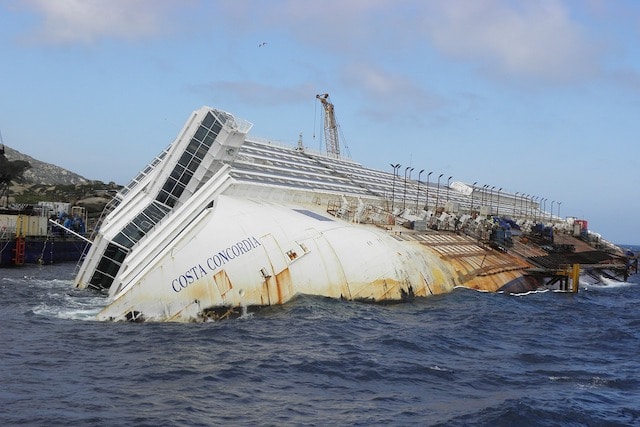
The Costa Concordia had performed a sail by salute under captain Schettino on at least one occasion before, but this time the decision proved to be disastrous. A navigation mistake brought the Costa Concordia even closer to Giglio Island than had been intended, and there was little margin for error.
At 9:42 p.m. the Costa Concordia collided with a rocky outcrop that tore a huge gash through her steel hull. The damage had been inflicted beneath the waterline, allowing water to flood into the ship.
The Costa Concordia had been designed to remain afloat if any two of her watertight compartments were flooded; with three of these compartments breached and seawater flooding into the engine room the Costa Concordia was in serious trouble.
Ironically, at the time of the impact one of the ship’s restaurants was playing Celine Dion’s “My Heart Will Go On,” the theme song to James Cameron’s 1997 film Titanic.
7. It Took More than an Hour for the Evacuation to be Sounded
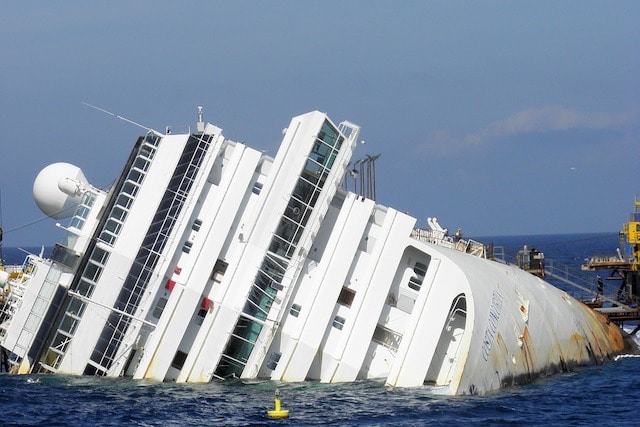
Nobody yet knew just how catastrophic the damage was, but it was immediately apparent that something was amiss.
The sound of rock tearing through metal had been audible throughout the ship; in the restaurants tables, glasses, and bottles smashed to the floor, and moments later a power cut plunged the ship into darkness. Soon after this the ship began to list as she took on water.
Legal requirements stipulate that passengers must undergo a muster drill within 24 hours of boarding. This had not yet been undertaken for the passengers who had embarked near Rome little more than two hours earlier.
These 696 people had no idea where they were expected to assemble for their lifeboats. None the less, as captain Schettino attempted to assess the severity of the damage, his crew assured passengers there was nothing to be worried about.
Some passengers took it on themselves to don lifejackets and assemble in the lifeboat areas. They were instructed, apparently on the captain’s orders, to return to their cabins or the restaurant areas.
The coast guard only learned that there was a problem when they were contacted by passengers and their concerned relatives. When they asked the Costa Concordia for more information at 10:14 p.m., they were told the ship had suffered a power failure but there was no serious problem.
It seems that Captain Schettino was either unwilling or unable to comprehend the enormity of what had happened. He didn’t order the evacuation of the ship until 10:55 p.m., more than an hour after the damage had been inflicted.
6. Captain Schettino Claimed to have Tripped into a Lifeboat
The Titanic and Costa Concordia disasters are separated by a span of almost exactly a century.
In the case of the Titanic, captain Edward John Smith numbered amongst the victims. While he bears at least some responsibility for the disaster, and questions have been raised as to his effectiveness in the aftermath, it seems he made no effort to save himself. Eyewitness accounts place him on the bridge when the ship slipped beneath the waves.
Captain Smith followed the naval tradition of the captain going down with his ship. This holds that the captain is ultimately responsible for the lives of everybody aboard. He or she is expected to remain on the ship until everybody else has been saved.
This did not happen in the case of the Costa Concordia’s captain Francesco Schettino, who was found to be safely aboard a lifeboat even while the evacuation of the stricken cruise ship continued.
Captain Schettino later made the unlikely claim that he had tripped and fallen into the lifeboat. This was contradicted by the emergence of grainy video footage that seemed to show him abandoning the Costa Concordia entirely of his own volition.
5. The Captain Failed to Return to the Ship
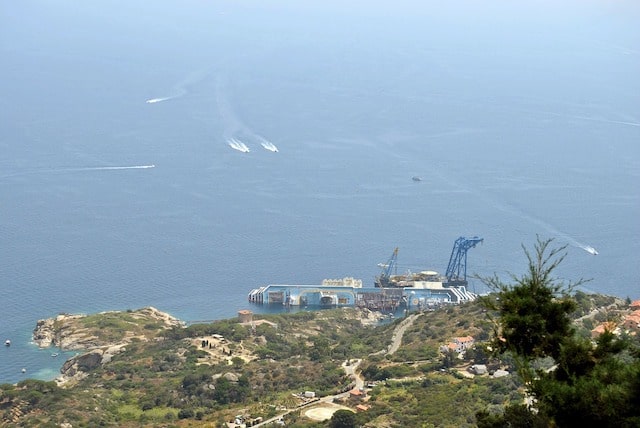
In the chaos of the evacuation the coast guard lost contact with captain Schettino. It was assumed he must still be on the stricken Costa Concordia, taking control of the evacuation effort. It therefore came as something of a surprise when he was found to be in a lifeboat heading away from the disaster.
A coast guard official named Gregorio De Falco explained in no uncertain terms exactly what he expected captain Schettino to do. He ordered him to return to his ship, climb the rope ladder at its prow, and report back on the situation and how many people were still awaiting rescue.
Captain Schettino wasn’t eager to comply. He complained that it was dark, the ship was listing, and that there were other boats blocking the way. However, this hadn’t prevented other rescuers, including the deputy mayor of Giglio Island, from boarding the ship to assist in the evacuation. So far as is known the captain made no attempt to return to the Costa Concordia.
While captain Schettino and his senior crew had abandoned ship, there was at least one senior officer doing his best to coordinate the rescue effort. However, it wasn’t one of the Costa Concordia’s officers. Roberto Bosio was captain of one of the Costa Concordia’s sister ships, the Serena, and had been on the Costa Concordia in an unofficial capacity when the disaster struck.
Bosio later condemned Schettino’s actions in the wake of the disaster as despicable. He even claimed to have given the first order to abandon ship while Schettino still dithered.
4. Some Lifeboats Weren’t Launched
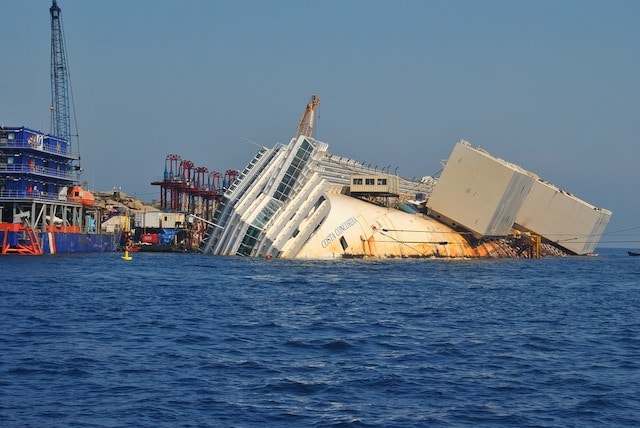
Cruise ships operate under strict safety regulations. One of the most important of these stipulates that every vessel must set sail with sufficient lifeboats for 125% of the ship’s maximum capacity. The Costa Concordia was no exception, and as far as is known she was fully compliant with this law. Despite this hundreds of people were unable to make it into the lifeboats.
The Costa Concordia was taking on huge amounts of water, and by the time the order to evacuate the ship had finally been given she was listing alarmingly to her starboard side.
While the captain managed to find his way onto a lifeboat, many of his passengers and crew were not so fortunate. The lifeboats on the portside couldn’t be launched once the Costa Concordia had listed beyond 20 degrees.
Some of the stranded passengers were lifted to safety by coast guard helicopters, others were forced to swim for shore. In the confusion not everybody had managed to get hold of a lifejacket.
A Frenchwoman named Nicole Servel and her husband, Francis, had just one between them. Francis, who was a strong swimmer, insisted his wife take the lifejacket before she jumped from the stricken ship into the water.
She managed to struggle through the water to Giglio Island, but she never saw her husband again. He numbered amongst those who lost their lives in the disaster.
3. The Disaster Cost Over $2 Billion and 32 People Lost Their Lives
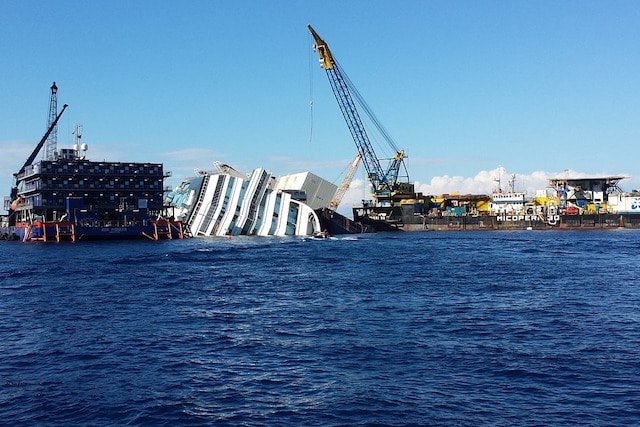
Captain Schettino and several of his crew would later face criminal charges for their part in the Costa Concordia disaster.
His defense team claimed he had averted an even greater catastrophe. They argued that if he hadn’t succeeded in steering the Costa Concordia into shallow waters, where she came to rest partially submerged on the seafloor, then the death toll would have been much higher.
The prosecution argued this had been down to luck rather than judgement, and that tides and winds prevented the powerless vessel drifting into deeper waters rather than any particular decision made by the captain.
The vessel was undoubtedly precariously positioned. While part of the ship remained out of the water, she rested on a rocky ledge just by a drop of one-hundred meters. Had the Costa Concordia been just a little farther out to sea, she would have been lost beneath the waves entirely.
While the disaster could have been even worse, and most of the passengers made it to safety, not everybody was so fortunate. Thirty-two people lost their lives. Divers found several of them trapped in one of the Costa Concordia’s elevators. The last victim wasn’t recovered from the wreckage until November of 2014.
2. It was One of the Biggest Salvage Operations Ever Undertaken
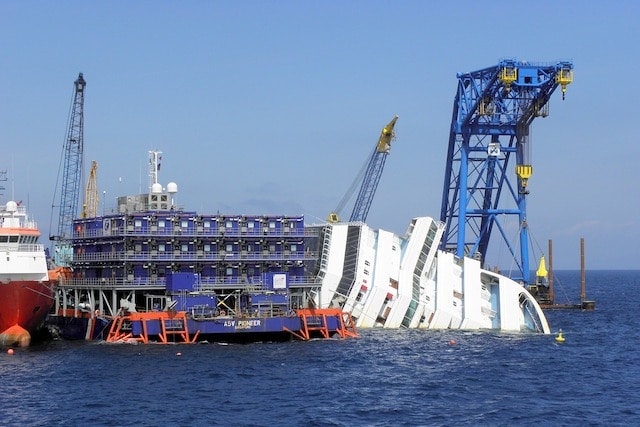
The hulking wreck of the partially submerged Costa Concordia loomed over the coast of Giglio Island for more than two years. Recovering the huge vessel would be the largest peacetime salvage mission ever undertaken, and perhaps more complex than anything ever attempted before.
A stricken 114,000 ton vessel represents a major salvage operation under any circumstances, but the Costa Concordia’s precarious position greatly magnified the difficulties.
Strong winds and tides, or even a mistake in the salvage operation itself, risked shifting the Costa Concordia into deeper waters. If this happened she might have sunk beneath the waves entirely, perhaps rendering her impossible to recover.
One possible solution was to slice the Costa Concordia into sections, each of which could then be removed individually. This was eventually dismissed due to the environmental damage it would cause.
Huge metal platforms were constructed around the Costa Concordia, and in September 2013 she was rolled upright. Water was then pumped out of the wreckage and the broken ship was finally towed on her final journey to be dismantled at the port of Genoa. The cost of the salvage operation alone has been estimated at over $1 billion dollars.
1. Captain Schettino Claimed he had been Made a Scapegoat
In the wake of the disaster captain Schettino was pilloried in the press, who dubbed him Captain Coward and the most hated man in Italy.
The captain was charged with manslaughter, causing a maritime accident, and abandoning ship. He argued that while he could not be absolved of all blame, he had been made a scapegoat for the systemic failures of Costa Cruises, the owners of Costa Concordia.
He may have had a point. The whole truth may never be known, since Costa Cruises managed to themselves avoid criminal prosecution by paying a paltry 1 million Euro fine.
The Costa Concordia’s officers didn’t have the option to buy themselves out of trouble. Several were jailed for their part in the disaster, as was the operator of the Costa Cruises crisis line for delays in reporting the accident to authorities.
In 2015 captain Schettino was sentenced to 16 years in prison. However, as he worked his way through the appeals process he didn’t set foot in a cell until as late as 2017, more than five years after the disaster.